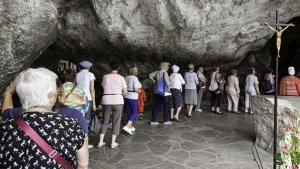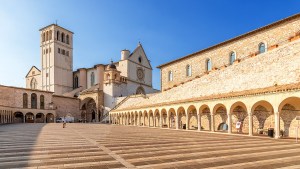Life is a journey, a pilgrimage. The word derives from Latin, peregrinare, literally meaning “to wander through fields of grain.” Pilgrimage seems to be almost instinctive to humankind. Throughout the centuries, people of all faiths and traditions have set out on sacred journeys or quests.
Pilgrimage in the Bible
The Bible is filled with narratives of God beckoning a person or people to go out from.The first biblical “pilgrimage” is recounted in Genesis 12: 1-4, when Abram was called by God to leave his pagan past and his father’s home in order to migrate to the land of God’s choice, where he would receive divine blessings. In Exodus, God asks Moses to lead his people out of slavery in Egypt to the Promised Land (see 12:37-19:8).
In the New Testament, God continues to call people to go forth, but the calling is largely centered on Jesus Christ. As in the Old Testament prophets, Jesus, whose “kingdom was not of this world,” listened to the voice of his Father, obeyed, and left his heavenly “home” by becoming incarnate in the world. Like the prophets, Jesus ultimately went to a better place after his Resurrection.
The rise of Christian pilgrimages
In time, Christians began to look at the spiritual life through the lens of pilgrimage. By the 4th century, largely as a result of the legalization of Christianity and an end to the persecutions, pilgrimages began in earnest.
The Christian Roman emperor, Constantine, built large basilicas in Rome over the tombs of Peter and Paul, as well as other basilicas in honor of Jesus, Mary, and John. Meanwhile, his mother, Helena, erected churches and shrines in Palestine to memorialize events from the Gospels.
These large edifices paved the way for Christians to come and offered them space in which to worship. At the same time, Helena brought relics from Jerusalem back to Europe, sparking even more interest in the holy places of Jesus’s earthly life. Thus, Christians from around the world slowly began to journey to the tombs of the martyred apostles in order to honor them, connect with the events of their lives, and do penance.
Inspired by the Crusaders
By the 11th century, the practice of pilgrimage had become widespread and entered into Christian devotional practice. The stories told by Crusaders after returning home piqued curiosity and increased the desire to experience the sacred places of Jesus’s life themselves.
Huge numbers of Christians of every class and status set out on the journey. While many went to the Holy Land, others went elsewhere. They went to Rome to visit the tombs and Basilicas of Peter and Paul, to Compostela in Spain to visit the tomb of St. James, to Loreto to the Holy House of Mary, to Monte Sant’Angelo to the grotto of St. Michael the archangel, and beyond.
They braved disease, violence, shipwrecks, and strife. Many never returned home, as there were so many risks. Before setting off, the pilgrim prepared a last will and testament, gave away or sold his/her possessions, and celebrated the Church’s sending-off liturgical rite similar to that of a funeral.
After donning the pilgrim’s tunic, the walking staff, and leather pouch, the pilgrim set off. A broad-brimmed hat was used with a long scarf wrapped around the body from the back to the waist. The symbol of the scallop shell was worn by those headed to the tomb of St. James in Compostela, while the keys were worn by those going to Rome. Those going to the Holy Land carried the Jerusalem cross. The distinctive dress set the pilgrims apart and identified them as such for protection.
Pilgrims also journeyed to lesser-known sites. Perhaps they had a devotion to a saint, and wanted to journey to his or her tomb. There were also sanctuaries built over places associated with the saint’s life: his birthplace, the site of her martyrdom or death, the place where he experienced something supernatural.
Interior pilgrimages
During this time, monks who never traveled beyond the confines of the cloister began using pilgrimage as a metaphor for the inner journey of the heart and soul. Associating the outer pilgrimage with the inward one, they sought to journey to heaven within.
The geographical pilgrimage fell into decline after the Protestant Reformation, which challenged the theology of the indulgence as well as medieval devotions. The Enlightenment of the 18th and 19th centuries virtually eliminated the devotional pilgrimage, which people rejected as a medieval superstition.
Modern pilgrimages
In recent decades, however, pilgrimages have made a comeback. Modern pilgrims have once again rediscovered the powerful spirituality of the faith journey. Certainly, jets, luxury coaches, and modern hotels have made the journey safer and less penitential. Nonetheless, jet lag, sore feet, and the absence of the comforts of home can still require patience, and penance.
Today’s pilgrims look forward to time away to experience God without the clutter in their lives. They hope to witness a miracle, sign, or truth. Others hope to find an answer to their heartfelt prayers.
Ultimately, the pilgrimage is a response within the soul to move closer to God, to leave the ordinary in order to embrace the unknown within the context of faith. Pilgrimage has a goal: to encounter the living God. Along the journey, the pilgrim receives special graces through the spirituality or sacredness of place, which has its origins in the theology of creation and the Incarnation. Pilgrimages are unique because they reveal an incarnate God – a God who comes among us. People are touched by God in actual places.
By going to the places where our predecessors experienced God, we can connect with the events and receive graces, too. Thus, the sacred places help us to connect with the living God – the God who “took on flesh and dwelt among us.”




